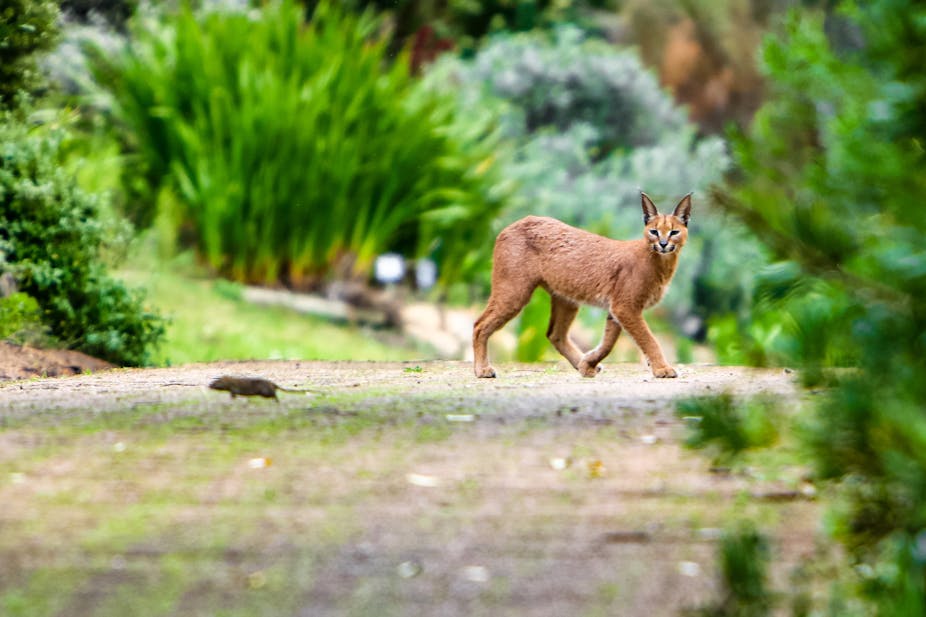If you live near or have visited Cape Town’s urban edge – where urban and natural areas meet – you may have been lucky enough to spot a caracal. These adaptable, medium-sized wild cats with distinctive long tufted ears can be found in other parts of the African continent too, as well as the Middle East, central Asia and India.
Caracals are the largest remaining predator in Cape Town, the world’s most biologically diverse city. It is estimated that there are around 50-60 caracals left on the Cape Peninsula. Our previous research has shown that the city’s caracals feed mainly on native, wild species, such as guinea fowl and vlei rats. And they choose to hunt for their prey close to the urban edge – particularly in areas where there are vineyards and wetlands nearby.
But this choice comes with risks. It means they need to cross roads to reach fragmented habitat patches; car collisions are an obvious threat. A less obvious one is persistent organic pollutants, or “forever chemicals”.
These long-lasting, toxic chemicals are largely invisible, travelling through air and water, and ending up even in the most remote environments. They affect both human and wildlife health. Since the 1940s they have been used in pesticides, industry and construction. These activities release the chemicals into air, soil and water. There they remain intact for long periods of time and may become widespread through natural processes.
These pollutants tend to accumulate in the body tissues of animals – especially predators. Chemicals build up in predators through the prey they eat, a process called biomagnification. This means predators can act as sentinels or indicators for the presence, diversity and level of pollutants in the environment.
Until now, most research on these chemicals has taken place in Europe and North America, with little focus on the Global South. Our research in Cape Town aims to address this gap. We’re investigating how local wildlife may be affected by a particularly toxic class of pollutants, the organochlorines. This group of man-made chemicals contains carbon, chlorine and several other elements. Among them are polychlorinated biphenyls, a group of highly carcinogenic chemicals formerly used in many industrial and consumer products.
We have studied the diet, hunting behaviour and pollutant levels in Cape Town’s caracals. Our latest findings reveal extensive exposure to these chemicals across the city’s complex mosaic of habitats.

Caracals as indicators of environmental health
Working with wildlife ecotoxicologist Rafael Mateo at Universidad Castilla in La Mancha, Spain, we looked at how the caracals were being exposed to pollutants.
Samples were collected from caracals captured in cage traps as part of our work to monitor their movements using GPS collars. Animals were sedated and blood samples were taken by a veterinarian. We also collected blood and fat samples from dead caracals picked up around Cape Town, mainly animals killed in collisions with cars.
We tested samples using gas chromatography-mass spectrometry, a method which can detect and quantify pollutant chemicals in tissue samples even at low concentrations.

A worrying trend emerged: caracals frequently hunt in areas where there is a higher risk of organochlorine exposure. Individuals that hunt closer to denser human populations, and in wetlands and vineyards, have higher levels of both the insecticide DDT (dichloro-diphenyl-trichloroethane) and polychlorinated biphenyls in their blood and fat tissues compared with those that hunt further away.
This link to vineyards is a trend we have picked up before when assessing exposure to another kind of pesticide, rat poisons. Caracals hunting in Cape Town’s vineyards, where prey is abundant, are also likely to be exposed to a cocktail of highly toxic anticoagulant rodenticides.
Read more: How we found out that rat poisons are killing wildlife in Cape Town
Caracals using areas with a higher density of electrical transformers had higher burdens of chemicals in the polychlorinated biphenyls group. This is likely due to polychlorinated biphenyls leaking from the coolant fluids used in electrical equipment. The chemicals were banned worldwide in the 1980s and South Africa is committed to phasing them out by 2025.
Together, our results suggest that many human-transformed landscapes can harm wildlife, through previous or ongoing use of “forever chemicals”.
What can be done
Although this study is the first of its kind for southern Africa, it adds to the growing body of evidence that predator indicator species can reveal exposure to pollutants across food webs in human-transformed areas.
The world’s cities represent a new type of ecosystem for wildlife. Many species have adapted to these landscapes. But in doing so, they are forced into contact with invisible risks, such as increased exposure to pollutants.
Where a habitat contains both risk and reward, it can be an “ecological trap”, accelerating local extinctions. Ecological traps are also a global issue requiring collective action.
To make cities around the world safer, cleaner places, the use of “forever chemicals” must be reduced in line with existing international agreements. Citizens can reduce their own pesticide use too, particularly the use of rat poison. Cleaning up urban wetlands and restoring them could go a long way to removing pollutants from the environment.
People should also take stock of existing chemical use. Safely disposing of obsolete chemicals and outdated or contaminated equipment is an essential step to reducing spillover into natural areas.
These efforts will ensure healthier cities – not only for wildlife but for people too.

